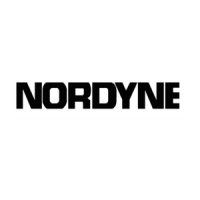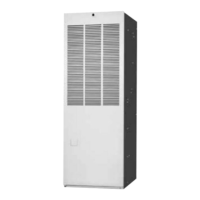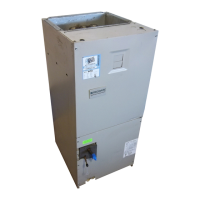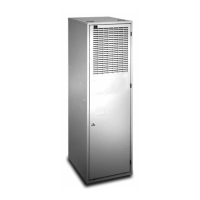30
Fan Mode
• When the thermostat energizes the G terminal for
continuous fan (without calling for heat or cooling), the
indoor fan is energized on the selected FAN speed.
• Ifacallforcoolingoccursduringcontinuousfan,the
blower will switch over to the selected COOL speed.
• IftheWterminalreceivesacallforheatduringcontinuous
fan, the blower will de energize.
• Acallforfanisignoredwhileinlockout.
• The blowerwilloperate at 50% oftheselected high
cooling speed for continuous fan operation in fixed
speed configuration and 35% of the selected high
cooling speed in variable speed configurations
MAINTENANCE
ELECTRICALSHOCK,FIREOREXPLOSION
HAZARD
Failuretofollowsafetywarningsexactlycould
resultinseriousinjuryorpropertydamage.
Improperservicingcouldresultindangerous
operation, seriousinjury,deathorproperty
damage.
• Beforeservicing,disconnect allelectrical
powertofurnace.
• Whenservicingcontrols,labelallwiresprior
todisconnecting.Reconnectwirescorrectly.
• Verifyproperoperationafterservicing.”
WARNING:
RISQUEDECHOCÉLECTRIQUE,D’INCENDIE
OU D’EXPLOSION
Le non-respect des avertissements de sécurité
pourrait entraîner
unfonctionnementdangereux
del’appareil,
desblessuresgraves,lamortou
desdommagesmatériels.
Un entretein incorrect pourrait entraîner un
fonctionnementdangereuxdel’appareil,des
blessuresgraves,lamortoudesdommages
matériels
• Couper toute alimentation électrique au
générateurd’airchaudavantdeprodéder
auxtravauxd’entretein.
• Aumomentdel’entretiendescommandes,
étiqueteztousleslsavantdelesdébrancher.
S’assurerdelesraccordercorrectement.
•S’assurer que l’appareil fonctionne
adéquatementaprésl’entretien.
AVERTISSEMENT:
OPERATING SEQUENCE
The operating sequences for the heating, cooling, and fan
modes are described below. Refer to the field and furnace
wiring diagrams: Figure 21 (page 25), Figure 22 (page
26), Figure 23 (page 26), Figure 24 (page 26) &
Figure 32 (page 40), Figure 33 (page 41), Figure 34
(page 42), & Figure 35 (page 43).
HeatingCycle
1. The thermostat calls for heat by energizing the W1
terminal with 24VAC.
2. The control checks to see the pressure switch is open.
If the switch is closed, the furnace will shut down for 5
minutes before retrying
3. If the pressure switch is open, the control energizes the
inducer motor and waits for the pressure switch to close.
The pressure switch must close within 12 seconds.
4. The control runs the inducer for a 30 second pre-purge
time.
5. The control energizes the igniter output for the
appropriate adaptive warm-up time limit.
6. The furnace always ignites the burners in high fire. If
the call for heat is for low rate, the furnace will move
down to low fire after the flames stabilize.
7. If the flame is proved and ignites the gas, the control
de-energizes the igniter. The gas valve and inducer
remains energized. The control goes to blower on delay.
8. The control energizes the blower on the selected HEAT
speed 22 seconds after the gas valve opened. The gas
valve and inducer remain energized.
9. If there is a call for high fire, the gas valve moves to the
high fire position and the blower speeds are increased.
The furnace will remain in high fire until the demand
for heat is satisfied.
10. If autostaging is enabled (single stage thermostat) the
demand for heat has lasted more than the selected
time, the furnace automatically moves up to high fire.
Autostage time is ON (10 minutes) or OFF, depending
on the Jumper (P7) setting on the furnace control board.
11. When the thermostat demand for heat is satisfied, the
control de-energizes the gas valve. The inducer output
remains on for a 30 second post-purge period.
12. The circulating air blower will continue to run for the
selected Blower Off Delay(P5). This may be 60, 90,
or 120 seconds depending on the jumper setting on
the furnace control board.
CoolingCycle
1. The thermostat calls for cooling by energizing the Y /
Y2 or Y1 terminal with 24VAC.
2. The control energizes the blower in the cooling speed
and sends 24VAC to the contactor in the condensing
unit.
3. When the thermostat removes the call for cooling, the
contactor in the outdoor condensing unit is de-energized
and the control continues to run the fan for a period of
60 seconds.
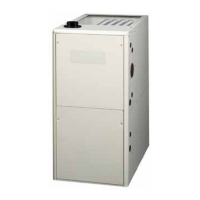
